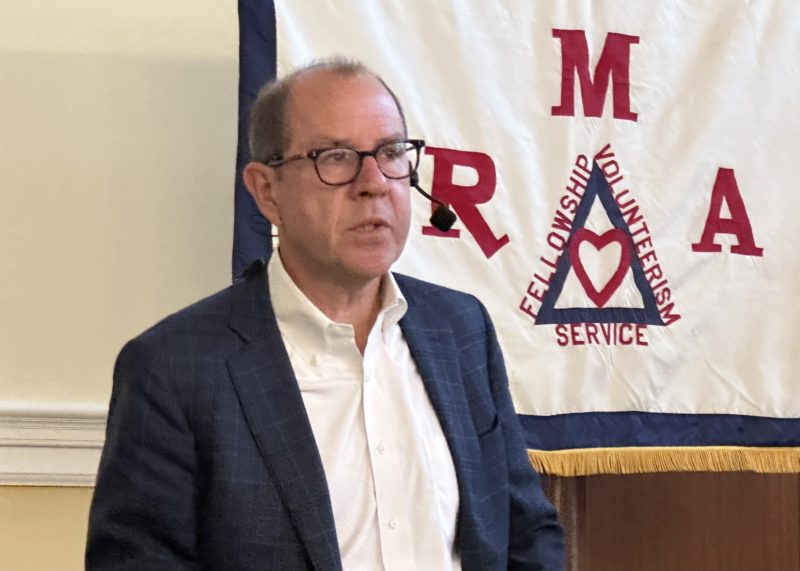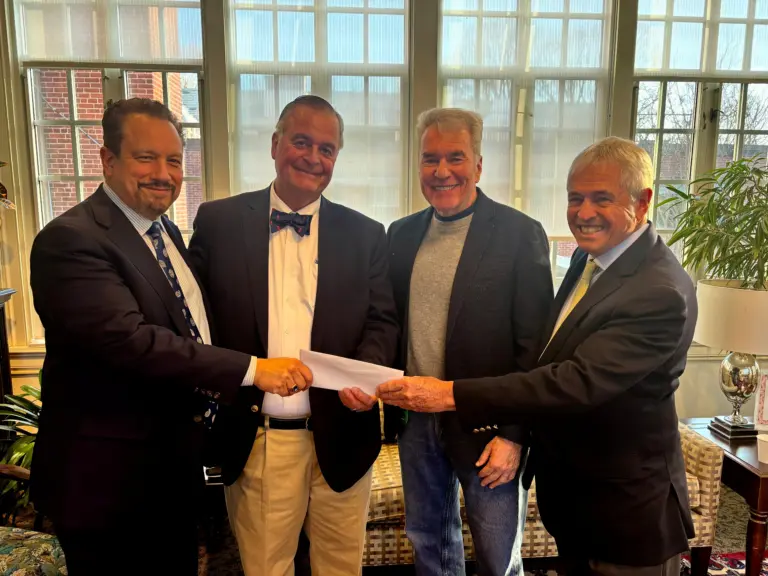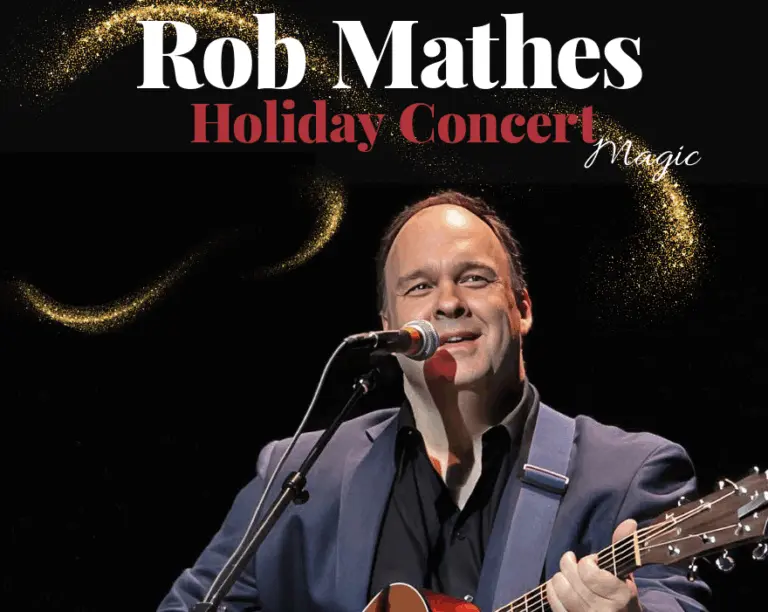
By Kris Bratberg
At the September 18 meeting of the Retired Men’s Association Jerry Coleman began by saying that the speaker of the day, Ted Aldrich, had previously spoken to the Greenwich RMA two years ago on his then just published historical study “The Partnership: George Marshall, Henry Stimson and the Extraordinary Collaboration That Won World War II.” It was a compelling slide presentation on one of the most consequential collaborations of the 20th Century. We were glad to have Ted back to discuss a related topic of that partnership, the US’s decision on how to use the atomic bomb against Japan in August 1945.
Ted was born and raised in Rowayton, graduated Colgate University, majoring in economics and political science, and earned an MBA from Boston College. Ted has had a distinguished career in banking beginning at UBS with posts in New York, Zurich, and London, specializing principally in commodities. He has held senior positions at Deutsche Bank, Fortis, and Mizuho Bank and currently works as the head of corporate development at Auramet Trading, one of the world’s largest physical precious metals merchants. Ted and his wife Susie have lived in Westport since 1999 where they raised their three sons.
Henry Stimson and George Marshall played pivotal roles in the decision to drop atomic bombs on Japan during World War II. This lecture explored the complex factors that led to this momentous decision, emphasizing that it was not made lightly or hastily. The story begins with Harry Truman’s unexpected ascension to the presidency in April 1945 after being chosen by FDR as his running mate for his third term. Truman, a relatively unknown senator just 11 months prior, found himself thrust into the role of the most powerful man in the world. He was initially unaware of the Manhattan Project, learning about it only after taking office.
As Truman grappled with the enormous responsibilities of the presidency, he was confronted with the ongoing casualties in the Pacific theater, particularly the brutal battle of Okinawa which resulted in 50,000 US casualties. In June 1945, Truman convened a meeting with top military brass to discuss strategies for defeating Japan. The Navy proposed a blockade, while the Air Force suggested continued bombing. General George Marshall, however, argued that an invasion of Japan would be necessary, as it had been in Germany. During this meeting, the atomic bomb was briefly mentioned but not seriously considered as an option, as it had not yet been successfully tested. In his presentation, Ted Aldrich emphasized that the decision to use the atomic bomb was not made in the brief period between its successful test on July 16, 1945, and its deployment on August 6. Rather, it was the culmination of years of consideration and planning. Henry Stimson, in particular, had been grappling with the moral and strategic implications of the bomb since learning of its potential in November 1941.
The primary factor driving the decision to use the atomic bomb was the desire to end the war quickly. By 1945, the United States was exhausted from years of conflict and economic hardship. The country had suffered the loss of 420,000 men, with another 672,000 wounded. The prospect of invading Japan, which some estimated could result in up to another million American casualties, was daunting. Additionally, the Japanese culture of no surrender, exemplified by the Bushido Code, led American leaders to believe that an invasion would be extraordinarily costly in terms of both American and Japanese lives. Another significant factor was the limited manpower available to the United States. Despite a large population, many men and women were needed in factories to support the war effort, not only for the U.S. but also for its allies. An invasion of Japan would require resources that were already stretched thin. Political considerations also played a role. Expanding the draft had met with significant resistance, and there were concerns about maintaining public support for the war effort.
The enormous cost of developing the atomic bomb, estimated at $2 billion (approx. $27 billion in today’s dollars), was another factor. There was a sense that having invested so much in the project, it would be difficult to justify not using it to end the war. Stimson, half-jokingly, remarked that the bomb’s successful test result meant he wouldn’t be sent to prison for the expenditure. The lecture also touched on other potential factors, such as a desire for revenge following Pearl Harbor and other Japanese atrocities. However, it dismissed the notion that racism was a primary motivator, pointing out that the bomb was initially developed for use against Germany.
Throughout the presentation, Aldrich emphasized the moral weight that Stimson, Marshall, and others felt in making this decision. They were deeply concerned about the loss of life on both sides and saw the atomic bomb as a means to end the war quickly and save lives in the long run. Aldrich deftly painted a picture of US leaders grappling with an unprecedented weapon in the context of a brutal, prolonged war. He highlighted the complexity of the decision-making process, involving military strategy, political considerations, ethical dilemmas, and the pressure of public opinion.
Aldrich also addressed common misconceptions about the decision. For instance, the choice to drop a second bomb on Nagasaki was part of the original plan, not a separate decision made after Hiroshima. The lecture also noted that even after both bombs were dropped, there was significant resistance within the Japanese leadership to surrender, illustrating the depth of the no-surrender mentality that American leaders were up against.
In conclusion, Aldrich presented the decision to use atomic bombs on Japan as both simple and complicated. Simple in that the primary goal was clear – to end the war as quickly as possible while minimizing the loss of American lives. Complicated in that it involved weighing numerous factors, including the potential for massive casualties in an invasion, the limited resources available, political pressures, and the moral implications of using such a devastating weapon. Aldrich’s approach, drawing heavily on primary sources like Stimson’s diaries, provided a nuanced view of the decision-making process. It challenged simplistic narratives about the use of atomic weapons, presenting it instead as a decision made by thoughtful, experienced leaders facing an unprecedented situation in the context of a global conflict that had already claimed millions of lives. This lecture serves not only as a historical account but also as a case study in leadership and decision making under extreme circumstances. It illustrates the complexities of wartime strategy, the interplay between military and political considerations, and the heavy moral burden borne by those in positions of power during times of conflict.
The talk can be viewed by going to the RMA website at https://greenwichrma.org, and clicking on “Speakers.”
The RMA’s upcoming presentation, “Ranking The Great Sportscasters:
Golden Age to the Digital Age,” by Bob Heussler, is scheduled for 11 AM on Wednesday, October 1, 2024. Some of the great events in sports history live on forever because a radio or television sportscaster masterfully captured the moment. We’ll revisit some of those events, learn more about the sportscasters who made them come alive, and rank the best to ever grace the booth.
Bob Heussler is a veteran radio and television sportscaster with over 35 years of experience working in New York and Connecticut. He was an update anchor for the country’s first all-sports radio station – New York City’s WFAN – for 30 years and remains with the station on a part-time basis. Heussler has a long association with the Fairfield University men’s basketball program as their radio and television play-by-play announcer, and was inducted into the school’s Athletic Hall of Fame in 2024. Heussler was the radio and television play-by-play announcer of the WNBA’S Connecticut Sun for 17 years, beginning with their inaugural season in 2003, and remains a back-up play-by-play radio announcer for the NBA’s Brooklyn Nets. He was a sportscaster for the Connecticut Radio Network for over 15 years, including several seasons as the radio play-by-play announcer for UConn basketball and football, and is a former network anchor at ESPN Radio. Heussler has instructed student broadcasters at Yale and Fairfield and was the longtime director of public relations at Milford Jai-Alai. A graduate of the University of Bridgeport, Heussler currently resides in Stamford.
To stream the presentation by Bob Heussler at 11 AM on Wednesday, October 2, click on https://bit.ly/30IBj21. This presentation will also be available on local public access TV channels, Verizon FIOS channel 24 and Optimum (Cablevision) channel 79. The public is also invited to attend the presentation in person at the First Presbyterian Church of Greenwich at 1 West Putnam Avenue.
Note: The views expressed in these presentations are those of the speakers. They are not intended to represent the views of the RMA or its members.
RMA speaker presentations are presented as a community service at no cost to in-person or Zoom attendees, regardless of gender. Any member of the public who would like to receive a weekly email announcement of future speakers should send a request to members@greenwichrma.org. The RMA urges all eligible individuals to consider becoming a member of our great organization, and thereby enjoy all the available fellowship, volunteer, and community service opportunities which the RMA offers to its members. For further information, go to https://greenwichrma.org/, or contact members@greenwichrma.org.




